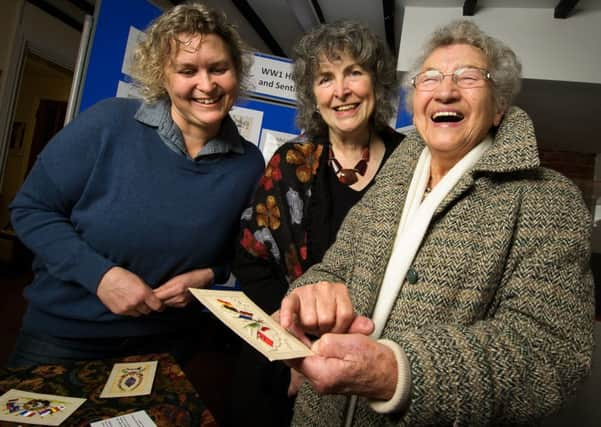The humour and romance from the dark days of war in Southam exhibition


And that is brought home by the World War One Humour and Sentiment Exhibition staged in Southam.
Poignant and romantic letters from mothers, wives and sweethearts – some which may have been sent not knowing their loved ones had been killed – can be read.
Advertisement
Hide AdAdvertisement
Hide AdWhile a style of funny postcards posted from the front – often sent from young soldiers putting on a brave face and trying to shield their loved ones from the horrors of trench warfare – are also on display.
The 36 cards were for decades on the walls of Billy and Maude Stephens’ barber shop in Market Hill, Southam.
Bernard Cadogan, chairman of the Southam Heritage Collection, said: “A lot of the older residents have told tales of them sitting and waiting for a haircut and reading the postcards.”
Billy Stephens served during the war and was an entertainer who did an impression of a star of the era called Little Titch, who wore oversize shoes – up to 24 inches – and Billy’s imitation shoes are also on show.
Advertisement
Hide AdAdvertisement
Hide AdThere are also 25 embroidered love-token cards sent from France by a Harry Hancock to his girl Nell, a silk weaver.
Still in pristine condition, they were loaned by Joyce Hancock, aged 89, of Coventry, Harry’s daughter-in-law, who said: “I was absolutely amazed and thrilled to bits when I saw the display.”
Mr Cadogan said: “A lot of the items on show are quite heart-warming and sentimental. It was very much a gentler society then. But it was a very different sort of war to any before – very brutal.”
There is also an autograph book donated to the exhibition by Southam resident Mary Williams which contains drawings by soldiers who were patients in the Voluntary Aid Detachment hospital in what is now the Grange Hall. One of the humorous drawings shows a portly man festooned with flags pressed on him by women collecting to buy treats for troops.
Advertisement
Hide AdAdvertisement
Hide AdMr Cadogan said about 1,000 troops were cared for at the hospital from 1917-1919, which they have no records of.
Also part of the display is what is known as Trench Art – where troops fashioned things such as military ware into art – are two old shell casings with poppy decorations that were passed on to Mr Cadogan’s wife Jill by her family.
He said: “They’ve been on our mantelpiece.”
Many Christmas cards are also on show – the irony being that many young men signed up to the colours for adventure, thinking the war would be over by Christmas 1914.
“There seems to have been a whole industry that built up during the war making things like cushions and coloured cards and tailoring them to the soldier’s regiments.”
Advertisement
Hide AdAdvertisement
Hide AdRecordings of songs popular during the war are also played and Mr Cadogan said: “ It’s not a dry and dusty exhibition – it shows the humour, pathos and romance from that era.”
He said curator Val Brodie, of Napton, had spent about two years researching for this exhibition and an earlier one which focussed on the role of women during the war and in the Southam area.
“Val has done a tremendous amount of work and without her dedication the two exhibitions would not have been possible.”
He said they are still accepting items and were keen to hear from people with family records and recollections of the war to add to the loaned and donated exhibits.
The exhibition is in the basement of Vivian House, Market Hill, and is open every Tuesday, 10am-noon, until Easter.
There is no wheelchair access. For assistance phone 613503 in advance.